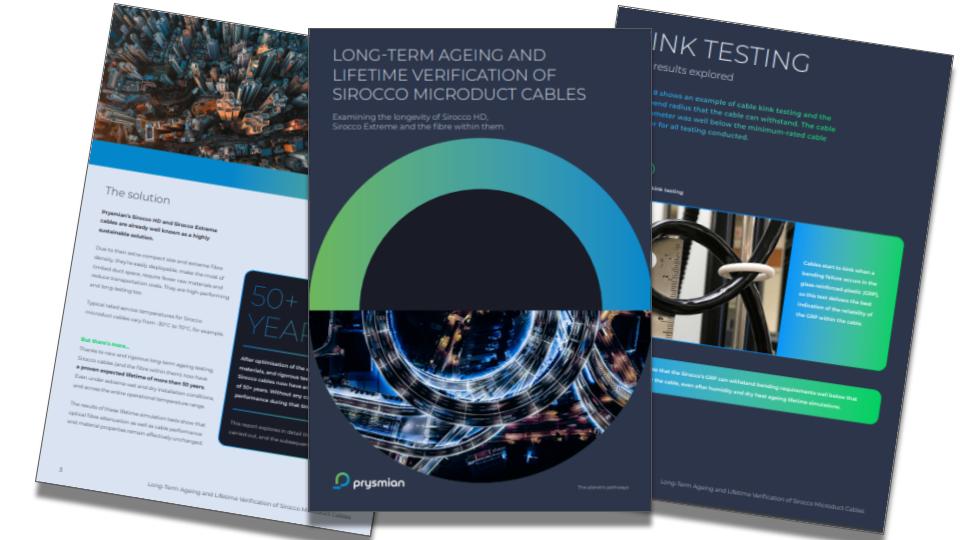For network operators, navigating the ever-increasing demand for bandwidth has become one of many constant challenges. And as data consumption only continues to grow, they need solutions that are not only efficient and scalable, but also built to endure the demands of the future.
What’s more, these solutions increasingly need to help with some of the other biggest challenges faced in today’s fibre landscape, including rising concerns surrounding environmental factors, such as heat and water degradation; a heightened need to ensure investor confidence; and tackling and financing rural deployment.
Enter Prysmian's Sirocco family of microduct cables, which has emerged as something of a frontrunner in helping to solve today’s challenges, thanks to a blend of compact design, performance, and future-proof technology.
Fibre optic cable density: Do more with less
At the heart of the Sirocco range is the ability to do more with less. For example, Prysmian's PicoTube technology shrinks the cable diameter by 25% compared to conventional microduct cables. In terms of what this means for operators, the reduced diameter allows for a higher fibre count within the cable, so network capacity can be increased without the need for additional duct space. Ian Griffiths, Global Digital Solutions R&D VP at Prysmian explains: “Sirocco Extreme is the world's first 180 micron cable. It is the densest and so allows operators to pack more fibres into a smaller space. This means that they can maximise the spare capacity they have in their network, so where they have existing ducts, they can fit more fibres in now than they previously could.”
Smaller cables also translate to lower material usage, which can help lead to cost savings during installation. A compact design additionally allows for more cables to be spooled per drum, minimising transportation requirements and streamlining the deployment process.
When it comes to that all-important sustainability, lower material usage and fewer transportation needs contribute to a smaller environmental footprint.
The miniaturisation of Sirocco cables is achieved through a combination of innovative design and cutting-edge materials. The company pioneered the development of ultra-thin coatings for the optical fibres within the cable. These coatings deliver exceptional performance without compromising on size, helping to enable a higher fibre count within the compact diameter.
A solution for high-density cable configurations
Sirocco cables incorporate bend-insensitive fibres that are particularly resilient to bends that can occur during installation or operation. Says Griffiths: “Moving to bend insensitive fibre allows the fibres to be packed tighter together within the cable, with less risk of macro or micro bend losses. Micro bend resilience is essential for cables that will experience wide temperature variations, as these can induce material shrinkage. Micro bends are especially likely to occur within high-density cables, as fibres can touch each other due to tight packing, material shrinkage or other strain effects." The bend insensitive technology can help to ensure optimal signal transmission, even in high-density cable configurations.
These bend-insensitive fibres are designed for wavelength division multiplexing (WDM) optics, a crucial technology for high-bandwidth applications, such as fibre-to-the-home (FTTH) and 5G networks. This compatibility is designed to ensure that Sirocco cables can deliver exceptional performance as network demands evolve.
Prysmian also developed a colour-coding system that incorporates coloured pigments directly into the secondary coating layer, in order to eliminate the need for an additional ink layer. This seemingly minor detail contributes to further size reduction and material efficiency. The foresight behind Sirocco's design ensures compatibility with existing G.652 fibres, allowing for ease of integration into existing network infrastructure. These cables are also primed to embrace future advancements in fibre optic technology, ensuring a future-proof solution for operators.
Rigorous testing demonstrates 50+ year cable life
If all of this were not enough, the icing on the cake for operators comes with Sirocco’s durability. Traditionally, the estimated lifespan of an optical fibre cable has been around 20-25 years. However, rising concerns surrounding environmental factors, such as heat and water degradation, and a heightened need for operators to ensure investor confidence prompted Prysmian to develop a more rigorous testing methodology for its cables.
The long-term ageing tests enhance the Sirocco family of microduct cables even further, demonstrating an expected lifetime exceeding 50 years. This could help operators to extend the window for network lifecycles, allowing them to make more informed investment decisions and plan for the longer term. Prysmian’s approach involved optimising the optical fibre materials and subjecting them to extensive testing regimes, designed to simulate real-world conditions.
Griffiths explains: “The idea behind the testing was that most document standards place the lifetime of an optical network, or optical cable at 20-25 years. We decided to test our cables to simulate a 50 plus year lifetime, so that, with this extreme rigorous testing, we can give operators the comfort of being able to put our cable in the ground and not have to worry about it for 50 years. In turn, they will be able to reassure their investors that they can work on a longer lifecyle analysis.”
Future-proofing sustainable fibre optic networks
These rigorous tests simulated real-world environmental stresses over an extended period. They encompassed both dry and wet ageing conditions, mimicking exposure to heat, moisture, and other environmental factors. With a guaranteed lifespan exceeding 50 years, operators can reduce the need for cable replacements, leading to cost savings over the extended life cycle of the network. The added durability also benefits operators by minimising the risk of cable failures, ensuring consistent, reliable network performance for a longer period.
The future importance of being able to demonstrate such longevity of a cable surrounds the undeniable environmental and economic benefits. As Griffiths points out, legislation around environmental product declarations (EPDs) will almost certainly become more prominent in near the future, placing a greater emphasis on the entire lifecycle of network infrastructure. In this context, Sirocco cables already offer a future-proof solution, with enhanced performance and also demonstrably lower environmental impact.



